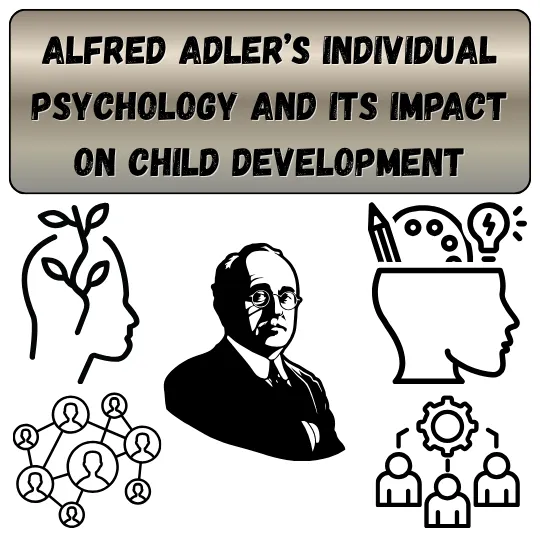What is Anxiety?
Anxiety is a common human emotion that can affect anyone and is usually a response to pressure, feeling afraid or feeling threatened (NHS – Every Mind Matters, 2021).
An Anxiety attack (which is an acute episode of intense anxiety) can feel overwhelming and can exaggerate the usual fight, flight and freeze response that our body creates to perceived dangers.
These anxiety attacks can be triggered when children experience sudden feelings of overwhelming fear, apprehension or panic, and they can be caused unexpectedly or caused by a specific stressor.
While a certain amount of anxiety can be normal and even helpful to get us through challenging situations, excessive and persistent anxiety can interfere with daily life (Anxiety Disorders – National Institute of Mental Health (NIMH))

Child Anxiety Attack Symptoms
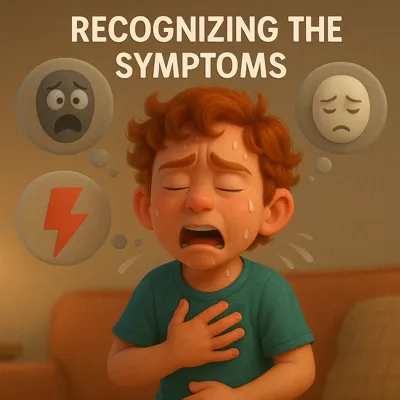
Many symptoms can be seen during an anxiety attack; these can be split into emotional and physical symptoms.
Emotional symptoms
The emotional symptoms that children can experience during an anxiety attack can include:
- Intense worry or fear – this can be experienced as a relatively sudden and intense feeling, such as a sense of impending doom.
- Feeling out of control – children might say or feel like they are going crazy or losing control.
- Feeling detached from reality – children might feel surreal or isolated.
Physical symptoms
The physical symptoms that children can experience during an anxiety attack include:
- Heart palpitations (rapid heartbeat) – where the child’s heart races or feels pounding.
- Hyperventilation or shortness of breath – children might describe this as being unable to breathe or feeling suffocating.
- Sweating or feeling hotter than usual – this can be accompanied by cold and clammy hands/feet
- Trembling and shaking – this will often be seen as involuntary shaking, over which the child has little control.
- Light-headedness – children might become faint and unsteady on their feet.
- Chest pains – children might describe that their chest feels tight.
- Nausea or upset stomach – children might experience stomach aches or feeling sick.
- Tingling sensations in their hands, feet, or face.
Supporting Children During an Anxiety Attack
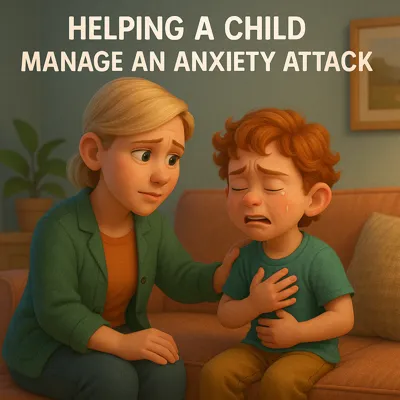
Supporting a child during an anxiety attack can be distressing and might require the support of more than one person.
To provide the best support to the child, you will need to adopt a calm and compassionate approach. Your goal will be to help guide the child through the anxiety and regain control and feel safe.
You can do this by:
Staying calm and offering reassurance.
Stay present and in the moment; the child will also be feeding off your energy, body language cues, and tone of voice. A calm, composed and reassuring approach will help the child to feel safe.
Acknowledging the child’s feelings while using a soothing tone will let them know that you are there and that their feelings are real and manageable.
Encourage Deep and Slow Breathing
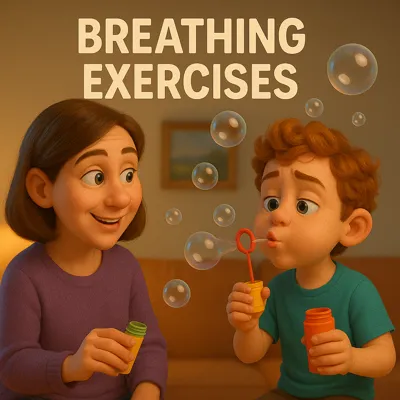
Using breathing techniques such as “box breathing” (3 breathing exercises to relieve stress) can be very effective in helping to regulate breathing and heart rate.
A more straightforward task could also be blowing bubbles, which will help reduce the physical symptoms of an anxiety attack.
Grounding Techniques
Grounding techniques can be beneficial for bringing children who are suffering from an anxiety attack back into the moment.
The 5-4-3-2-1 technique is very effective. You ask the child to name:
- five things that they can see,
- four things that they can feel,
- three things that they can hear,
- two things that they can smell and
- one thing they can taste.
Offering Physical Comfort
This might not always be appropriate, and in some cases, physical touch can re-trigger or heighten an anxiety attack, as some children will prefer space during this time.
If physical touch is appropriate, a hug, a hand on the shoulder, and holding the child’s hand can all help reassure the child.
Using Distraction Techniques
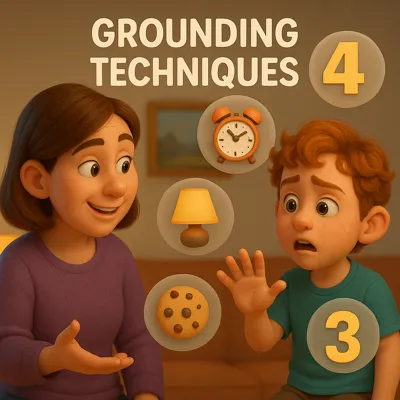
Drawing, colouring or solving a puzzle can all distract the child; this will help them shift their attention away from the anxiety and towards a neutral activity.
Like the 5-4-3-2-1 technique, asking children to count or name objects around them can help redirect their minds.
Providing a Safe Space
When possible, you should move the child to a quieter, calmer environment where they can have space to pace, sit or lay down and be comfortable.
Moving them to another location could also be done to protect them, such as moving them from areas that present a risk or danger to them or others.
Reducing sensory overload (and audience in a busy environment such as a school) can help children feel less overwhelmed.
Reassure and Normalise the Experience
This might have better results with older children, but explaining to the child that their body is reacting to anxiety and that the moment will pass can help them understand what’s happening to them.
Explaining that lots of people experience anxiety can help them to feel less embarrassed.
Post Anxiety Attack Support
Following the anxiety attack, calmly have a conversation with the child to understand what happened, what helped and what they can do next time.
During this time, you might be able to identify triggers or stressors.
Professional support in the form of Cognitive Behavioural Therapy (CBT) can be very beneficial in managing and overcoming anxiety in children.
CBT provides a structured and evidence-based approach, where the therapist can help to teach children various strategies and techniques that can help them manage any future anxiety attacks.
This professional support can provide reassurance and confidence to both the child and the caregiver.
Conclusion
Supporting a child who is experiencing an anxiety attack is a significant responsibility that requires an adult who can offer calm, compassion and safety to the child.
As a supportive adult, you play a crucial role in providing a safe and supportive environment for the child during these challenging moments.
By guiding the child through calming techniques and distractions and by providing a safe and supportive environment, you can successfully help the child navigate their anxiety attack.
Over time, especially with the support of CBT (Overview – Cognitive Behavioural Therapy (CBT), 2021), children can learn multiple techniques which will help them to manage their anxiety with confidence.
This journey of learning and growth can bring hope and optimism to both the child and the caregiver.
